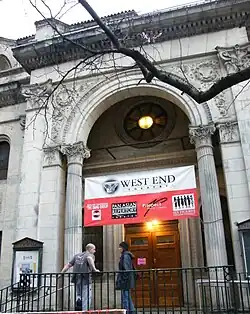Pan Asian Repertory Theatre
The Pan Asian Repertory Theatre is a New York City-based theatre group that explores the Asian-American experience and provides professional opportunities for Asian-American artists to collaborate. Pan-Asian was founded by Tisa Chang and Ernest Abuba in 1977, and Chang remains artistic director.[1] Chang established the Pan Asian Repertory Theatre as a resident company at La MaMa Experimental Theatre Club in 1977, with the intention of popularizing Asian-American theater and leading to other similar theatre companies in cities with an Asian disaporic population.[2][3]

Specializing in intercultural productions of new Asian-American plays,[3] Asian classics in translation, and innovative adaptations of Western classics,[2] some of the works Pan Asian has presented included:
- Empress of China - featuring Tina Chen in the title role of China's last dowager ruler
- Yellow Fever - continued to an Off-Broadway run
- Ghashiram Kotwal - Marathi play with music
- Teahouse - by Lao She, spanning fifty years of modern Chinese history
- Cambodia Agonistes - by Ernest Abuba, music by Louis Stewart
- The Teahouse of the August Moon - by John Patrick
- Forbidden City Blues - by Alexander Woo
- The Fan Tan King - by C. Y. Leethe, world premiere
- Yohen - by Philip Kan Gotanda
- Tea - by Velina Hasu Houston, 20th anniversary production
- Ching Chong Chinaman at the Westside Theatre[4]
Pan Asian has staged early works of writers including Momoko Iko, Wakako Yamauchi, Philip Kan Gotanda, R. A. Shiomi, and David Henry Hwang. When they established a residency program in 1987, Pan Asian became the United States' first resident Asian American theater company continuing with Chang's goal to showcase Asian American theater as having a role in the city's theater scene.[5][6]
See also
References
- Harry Haun, "40 Years On, Pan Asian Rep Still Uses Art as Protest", Playbill, June 16th, 2017
- Mel Gussow, "A Stage for All the World of Asian-Americans", New York Times, April 22nd, 1997.
- Alipio, Amy (2022-06-10). "These groundbreaking theaters shine a spotlight on Asian stories". National Geographic. Retrieved 2022-06-23.
- Kung, Michelle (2010-04-05). "Ching Chong Chinaman Playwright Explains Controversial Title". Wall Street Journal. ISSN 0099-9660. Retrieved 2022-06-23.
- Lee, Esther Kim (2006-10-12). A History of Asian American Theatre. Cambridge University Press. pp. 43, 90–92. ISBN 978-0-521-85051-3.
- Bowles, Elinor (1993). Cultural Centers of Color: Report on a National Survey. National Endowment for the Arts. pp. 102–103.